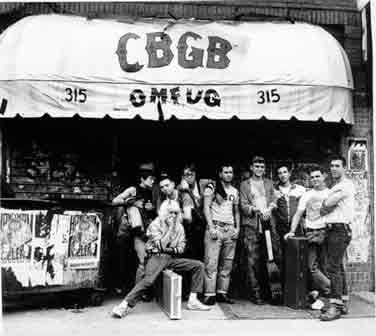Stop #12: CBGB’s

Moving south and slightly west, we come to the former location of CBGB, which stands for Country Blue Grass Blues, at 315 Bowery. This became the primary venue for the proto punk scene in the 1970s. Patti Smith and Television began playing here early on. Later, bands like the Ramones, the Talking Heads, and Blondie also shared the stage.
Tom Verlaine (who named himself after Rimbaud’s lover, Paul Verlaine) discovered the venue when he walked by and saw it as a great new place to perform his music. Television began playing there regularly and eventually brought Smith and Kaye to the club in 1974 (Shaw, 79).
Continuing a connection between the Beat generation and the new generation of punk rockers, William S. Burroughs was a frequent visitor to the music club. Although he was much older than the performers and members of the audience, he sat up near the front of the stage and actively participated in the shows and supported the up and coming musicians.
In describing the musicians that played at CBGB and their connection to poetry, Kane states,
Musicians looked to poetry not just in terms of what the art had to offer them as a model for their own songwriting but also as a form that could provide them with ways of thinking about how to make actual lifestyle choices. That is to say, poetry was both something they read and, in one form or another, something they tried to live (191).
In a way, musicians like Patti Smith, Lenny Kaye, Tom Verlaine, and Richard Hell were trying live poetry through their music.
CBGB eventually became a rock n’ roll icon and began to grab bigger crowds and bigger names but it was the early punk movement that started it all for the small grungy venue. CBGB eventually closed in October of 2006.
Last Stop: The Bitter End



The view of a non-native Nebraskan
I found this article by Meghan Daum this weekend about Nebraska, and particularly Lincoln, from the view of someone who moved there from the East Coast. Having grown up just outside of Lincoln and moved away, it’s very interesting to consider the area from a viewpoint the very opposite of mine.
She points out one of the things that drove me away but now miss more than anything.
Leave a comment
Posted in Commentary
Tagged Lincoln, Meghan Daum, Nebraska, Smithsonian